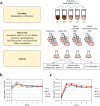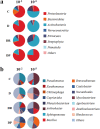Metagenomic and functional analyses of the consequences of reduction of bacterial diversity on soil functions and bioremediation in diesel-contaminated microcosms
- PMID: 26972977
- PMCID: PMC4789748
- DOI: 10.1038/srep23012
Metagenomic and functional analyses of the consequences of reduction of bacterial diversity on soil functions and bioremediation in diesel-contaminated microcosms
Abstract
The relationship between microbial biodiversity and soil function is an important issue in ecology, yet most studies have been performed in pristine ecosystems. Here, we assess the role of microbial diversity in ecological function and remediation strategies in diesel-contaminated soils. Soil microbial diversity was manipulated using a removal by dilution approach and microbial functions were determined using both metagenomic analyses and enzymatic assays. A shift from Proteobacteria- to Actinobacteria-dominant communities was observed when species diversity was reduced. Metagenomic analysis showed that a large proportion of functional gene categories were significantly altered by the reduction in biodiversity. The abundance of genes related to the nitrogen cycle was significantly reduced in the low-diversity community, impairing denitrification. In contrast, the efficiency of diesel biodegradation was increased in the low-diversity community and was further enhanced by addition of red clay as a stimulating agent. Our results suggest that the relationship between microbial diversity and ecological function involves trade-offs among ecological processes, and should not be generalized as a positive, neutral, or negative relationship.
Figures






Similar articles
-
Recovery of microbial diversity and activity during bioremediation following chemical oxidation of diesel contaminated soils.Appl Microbiol Biotechnol. 2014 Mar;98(6):2751-64. doi: 10.1007/s00253-013-5256-4. Epub 2013 Oct 5. Appl Microbiol Biotechnol. 2014. PMID: 24092007
-
Phylogenetic and Functional Diversity of Total (DNA) and Expressed (RNA) Bacterial Communities in Urban Green Infrastructure Bioswale Soils.Appl Environ Microbiol. 2017 Aug 1;83(16):e00287-17. doi: 10.1128/AEM.00287-17. Print 2017 Aug 15. Appl Environ Microbiol. 2017. PMID: 28576763 Free PMC article.
-
Maintenance of soil functioning following erosion of microbial diversity.Environ Microbiol. 2006 Dec;8(12):2162-9. doi: 10.1111/j.1462-2920.2006.01098.x. Environ Microbiol. 2006. PMID: 17107557
-
[Soil microbial ecological process and microbial functional gene diversity].Ying Yong Sheng Tai Xue Bao. 2006 Jun;17(6):1129-32. Ying Yong Sheng Tai Xue Bao. 2006. PMID: 16964955 Review. Chinese.
-
Soil-specific limitations for access and analysis of soil microbial communities by metagenomics.FEMS Microbiol Ecol. 2011 Oct;78(1):31-49. doi: 10.1111/j.1574-6941.2011.01140.x. Epub 2011 Jun 28. FEMS Microbiol Ecol. 2011. PMID: 21631545 Review.
Cited by
-
Influences of anthropogenic land use on microbial community structure and functional potentials of stream benthic biofilms.Sci Rep. 2017 Nov 8;7(1):15117. doi: 10.1038/s41598-017-15624-x. Sci Rep. 2017. PMID: 29118402 Free PMC article.
-
Construction of Simplified Microbial Consortia to Degrade Recalcitrant Materials Based on Enrichment and Dilution-to-Extinction Cultures.Front Microbiol. 2020 Jan 10;10:3010. doi: 10.3389/fmicb.2019.03010. eCollection 2019. Front Microbiol. 2020. PMID: 31998278 Free PMC article.
-
Mining of two novel aldehyde dehydrogenases (DHY-SC-VUT5 and DHY-G-VUT7) from metagenome of hydrocarbon contaminated soils.BMC Biotechnol. 2021 Mar 1;21(1):18. doi: 10.1186/s12896-021-00677-8. BMC Biotechnol. 2021. PMID: 33648490 Free PMC article.
-
Engineering complex communities by directed evolution.Nat Ecol Evol. 2021 Jul;5(7):1011-1023. doi: 10.1038/s41559-021-01457-5. Epub 2021 May 13. Nat Ecol Evol. 2021. PMID: 33986540 Free PMC article.
-
Paenibacillus sp. Strain OL15 Immobilized in Agar as a Potential Bioremediator for Waste Lubricating Oil-Contaminated Soils and Insights into Soil Bacterial Communities Affected by Inoculations of the Strain and Environmental Factors.Biology (Basel). 2022 May 9;11(5):727. doi: 10.3390/biology11050727. Biology (Basel). 2022. PMID: 35625455 Free PMC article.
References
-
- Sutherland W. J. et al. Identification of 100 fundamental ecological questions. J Ecol 101, 58–67 (2013).
-
- Balvanera P. et al. Quantifying the evidence for biodiversity effects on ecosystem functioning and services. Ecol Lett 9, 1146–1156 (2006). - PubMed
-
- Wu J. et al. Testing biodiversity-ecosystem functioning relationship in the world’s largest grassland: overview of the IMGRE project. Landscape Ecol 10.1007/s10980-015-0155-y (2015). - DOI
Publication types
MeSH terms
Substances
LinkOut - more resources
Full Text Sources
Other Literature Sources

